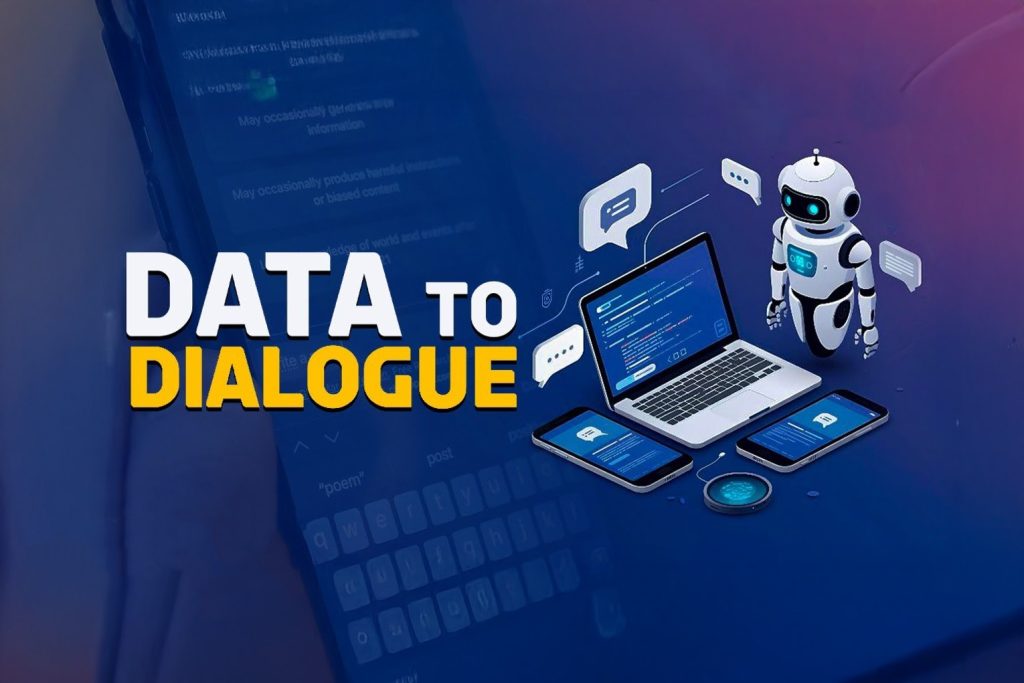How Machines Learn to Write: From Data to Dialogue
Have you ever paused to wonder how machines like ChatGPT can write stories, answer questions, or even hold conversations that feel surprisingly human? Artificial Intelligence (AI) isn’t just a tool for crunching numbers anymore—it’s now a creative collaborator. But how exactly does it work? In this blog post, we’ll explore the fascinating world of machine writing—from raw data to natural dialogue—and reveal how AI is transforming the way we communicate.
Why Machine Writing Matters?
Imagine a world where machines write essays, generate reports, or even craft novels. This isn’t a far-off fantasy—it’s happening now through Natural Language Generation (NLG). NLG is a subset of Artificial Intelligence that enables computers to create human-like text. Whether it’s a news article, chatbot reply, or personalized email, NLG is behind the scenes, shaping how we consume and interact with information.
“Natural Language Generation is not only about automation; it’s about amplifying human communication.” (Gatt and Krahmer, 2018)
What Is Natural Language Generation (NLG)?
Natural Language Generation (NLG) is a branch of Natural Language Processing (NLP) focused on converting structured data into human-readable text. Think of it as the brain that helps machines talk like us.
✦ Key Applications of NLG:
- Automated Content Creation – News articles, weather forecasts, sports summaries, financial reports.
- Customer Communication – Powering chatbots and virtual assistants with natural-sounding replies.
- Data Accessibility – Turning complex analytics into plain language summaries.
- Creative Writing – Drafting stories, lyrics, and even poetry.
The NLG Pipeline: From Data to Words
To write like a human, machines follow several stages:
- Content Determination – Decide what to say.
- Text Structuring – Organize the flow of information.
- Sentence Aggregation – Group related ideas.
- Linguistic Realization – Convert structure into grammatically correct sentences.
Example:
- Raw Data: 75°F, cloudy, chance of rain.
- NLG Output: “It’s 75°F with a chance of rain in Austin today.”
How Machines Learn to Write
At the heart of AI writing are powerful language models like GPT (Generative Pre-trained Transformer) and T5 (Text-to-Text Transfer Transformer). These models are built on transformer neural networks that learn the patterns of human language.
✦ The Learning Process:
- Pre-training on Large Texts: AI reads millions of books, articles, and websites to learn how language works.
- Contextual Understanding: Attention mechanisms help it focus on the most relevant parts of input text.
- Fine-tuning for Tasks: Models are customized for tasks like translation, summarization, or chatbot conversations.
- Text Generation: AI predicts the next word in a sentence based on the previous context, producing coherent output.
“Transformer-based models have revolutionized NLP, enabling machines to generate human-like language with remarkable fluency” (Vaswani et al., 2017).
Mimicking Human Writing
Modern AI doesn’t just regurgitate facts—it adapts, creates, and personalizes.
✦ Human-like Traits in AI Writing:
- Context Awareness: Understands nuance and relevance.
- Tone Adaptation: Writes formally, casually, or creatively depending on need.
- Personalization: Learns from user inputs to tailor responses.
Tools like ChatGPT, Jasper, and Copy.ai are making these capabilities widely accessible.
Real-World Applications
AI-generated writing is reshaping industries. Here are some examples:
✦ Virtual Assistants:
- Siri, Alexa, and Google Assistant use NLG to engage users in conversation.
✦ Automated Journalism:
- News agencies use AI to write earnings reports and sports recaps based on raw data.
✦ Business Intelligence:
- AI transforms complex dashboards into easy-to-read summaries, helping leaders make data-driven decisions.
“AI tools are helping organizations communicate more efficiently by translating complex insights into plain language” (McKinsey & Company, 2020).
From Algorithms to Art
Would you trust AI to write for you? Whether it’s drafting an email, summarizing your meeting notes, or even writing a poem, AI is no longer just a tool—it’s a partner in communication and creativity.

As we continue to develop machines that turn data into meaningful dialogue, we’re entering a new era—where technology doesn’t just inform, but truly converses with us.
What Do You Think?
Do you believe AI can write as well as a human? Would you use it for your next project? Share your thoughts in the comments!
Don’t forget to visit our website for more insights on tech trends, AI innovations, and the future of machines learn to write from data to dialogue
For further assistance, visit our channel and refer the video

References
- Gatt, Albert, and Emiel Krahmer. “Survey of the State of the Art in Natural Language Generation: Core tasks, applications and evaluation.” Journal of Artificial Intelligence Research, vol. 61, 2018, pp. 65-170.
- Vaswani, Ashish, et al. “Attention Is All You Need.” Advances in Neural Information Processing Systems, 2017.
- McKinsey & Company. “The State of AI in 2020.” McKinsey.com, 2020. https://www.mckinsey.com/featured-insights/artificial-intelligence
- OpenAI. “GPT-4 Technical Report.” OpenAI, 2023. https://openai.com/research
Share This :

